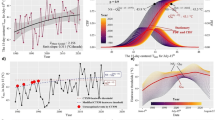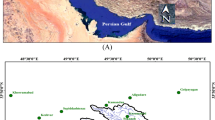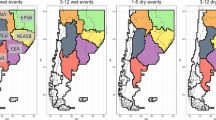Abstract
Precipitation is an important part of the hydrologic cycle, and its complexity is closely related to surface runoff and changing groundwater dynamics, which in turn influences the accuracy of precipitation forecasts. In this study, we used the Lempel–Ziv algorithm (LZA) and a multi-scaling approach to assess precipitation complexity for 1958–2011 by analyzing time series data from 28 gauging stations located throughout Jilin province, China. The spatial distribution of normalized precipitation complexity was measured by LZA, a symbolic dynamics algorithm, and by a multi-scaling approach, which is described by fractals. In addition, the advantages and limitations of these two methods were investigated. The results indicate that both methods are applicable and consistent for calculating precipitation complexity, and that the degree of relief is a primary factor controlling precipitation complexity in the mountainous area; in the plain terrain, however, the prominent influencing factor is climate.







Similar content being viewed by others
References
Bárdossy A, Pegram G (2013) Interpolation of precipitation under topographic influence at different time scales. Water Resour Res 49(8):4545–4565
Gilbert EN, Kadota TT (1992) The Lempel-Ziv algorithm and message complexity. IEEE Trans Inf Theory 38(6):1839–1842
Huang XR, Zhao JW, Yang PP (2015) Wet-dry runoff correlation in Western Route of South-to-North Water Diversion Project, China. J Mt Sci 12(3):592–603
Johansson B, Chen D (2003) The influence of wind and topography on precipitation distribution in Sweden: statistical analysis and modelling. Int J Climatol 23(12):1523–1535
Kantz H, Schreiber T (2003) Nonlinear time series analysis. Cambridge University Press, Cambridge
Lempel A, Ziv J (1976) On the complexity of finite sequences. IEEE Trans Inf Theory 22(1):75–81
Luan QH, Wang H, Xia DZ (2011) Complexity analysis of precipitation in changing environment in Chien River Basin, China. Water Sci Eng 4(2):133–142
Mandelbrot BB (1983) The fractal geometry of nature, vol 173. W.H. Freeman and Company, New York
Marani M (2005) Non-power-law-scale properties of rainfall in space and time. Water Resour Res 41(8)
Mihailović DT, Nikolić-Đorić E, Drešković N, Mimic G (2014) Complexity analysis of the turbulent environmental fluid flow time series. Phys A 395:96–104
Mihailović DT, Drešković N, Mimić G (2015a) Complexity analysis of spatial distribution of precipitation: an application to Bosnia and Herzegovina. Atmos Sci Lett 16:324–330
Mihailović DT, Mimić G, Drešković N et al (2015b) Kolmogorov complexity based information measures applied to the analysis of different river flow regimes. Entropy 17(5):2973–2987
Molnar P, Burlando P (2008) Variability in the scale properties of high resolution precipitation data in the Alpine climate of Switzerland. Water Resour Res 44(10)
Noh SJ, An H, Kim S, Kim H (2015) Simulation of soil moisture on a hill slope using multiple hydrologic models in comparison to field measurements. J Hydrol 523:342–355
Ortíz WR, Cruz L (2013) An integrated and evolutionary dynamical systems view of climate complexity. Int J Geosci 4:49–57
Over TM (1995) Modeling space-time rainfall at the mesoscale using random cascades. Dissertation, University of Colorado, Colorado, USA
Over TM, Gupta VK (1994) Statistical analysis of mesoscale rainfall: dependence of a random cascade generator on large-scale forcing. J Appl Meteorol 33:1526–1542
Özger M, Mishra AK, Singh VP (2010) Scaling characteristics of precipitation data in conjunction with wavelet analysis. J Hydrol 395:279–288
Randall DA, Dazlich DA (1991) Diurnal variability of the hydrologic cycle in a general circulation model. J Atmos Sci 48(1):40–62
Razavi S, Elshorbagy A, Wheater H, Sauchyn D (2015) Toward understanding nonstationarity in climate and hydrology through tree ring proxy records. Water Resour Res 51(3):1813–1830
Sen AK (2009) Complexity analysis of riverflow time series. Stoch Env Res Risk Assess 23(3):361–366
Serinaldi F, Zunino L, Rosso OA (2014) Complexity–entropy analysis of daily stream flow time series in the continental United States. Stoch Env Res Risk Assess 28(7):1685–1708
Shelton ML (2009) Hydroclimatology: perspectives and applications. Cambridge University Press, Cambridge, UK
Talebinejad M, Chan ADC, Miri A (2011) A Lempel-Ziv complexity measure for muscle fatigue estimation. J Electromyogr Kinesiol 21(2):236–241
Tang L, Lv H, Yang F, Yu L (2015) Complexity testing techniques for time series data: a comprehensive literature review. Chaos, Solitons Fractals 81:117–135
Zeeh C (2003, January). The lempel ziv algorithm. http://w3studi.informatik.uni-stuttgart.de/~zeehca/Seminar/LempelZivReport.pdf [accessed November 3, 2003]
Acknowledgments
This study was funded by the National Nature Science Foundation of China (No. 41572216). The co-authors would like to express their appreciation to Dr. Chen S. M. for reviewing an early version of this manuscript and for his constructive suggestions.
Author information
Authors and Affiliations
Corresponding author
Rights and permissions
About this article
Cite this article
Zhang, Q., Liang, X., Fang, Z. et al. Complexity analysis of precipitation using the Lempel–Ziv algorithm and a multi-scaling approach: a case study in Jilin province, China. Stoch Environ Res Risk Assess 31, 1697–1707 (2017). https://doi.org/10.1007/s00477-016-1314-7
Published:
Issue Date:
DOI: https://doi.org/10.1007/s00477-016-1314-7




